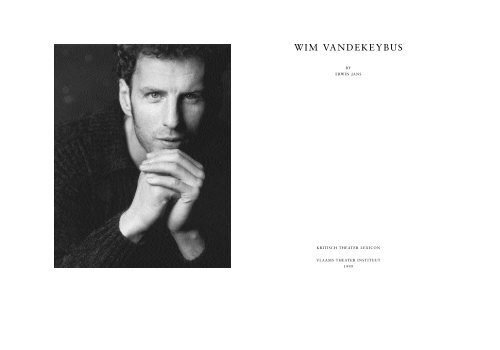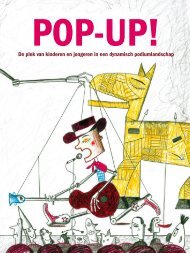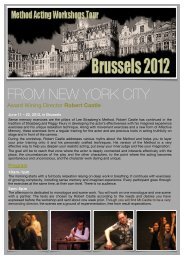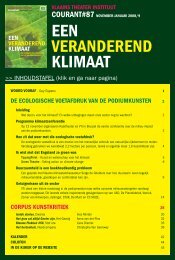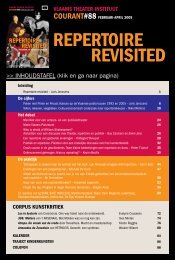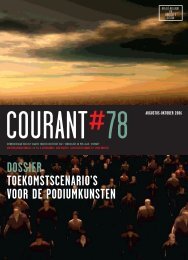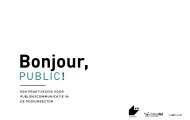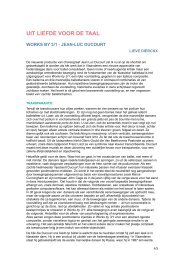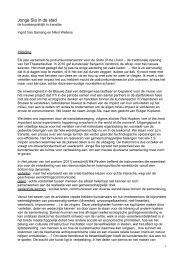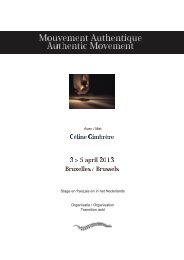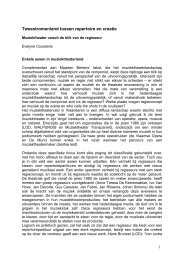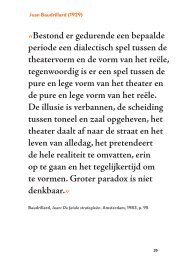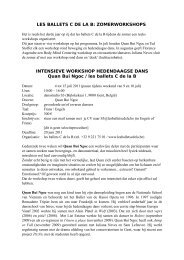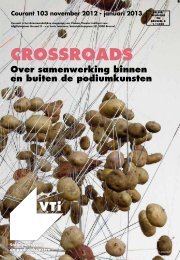Vandekeybus (Engels) - depot voor het VTi
Vandekeybus (Engels) - depot voor het VTi
Vandekeybus (Engels) - depot voor het VTi
You also want an ePaper? Increase the reach of your titles
YUMPU automatically turns print PDFs into web optimized ePapers that Google loves.
WIM VANDEKEYBUS<br />
BY<br />
ERWIN JANS<br />
KRITISCH THEATER LEXICON<br />
VLAAMS THEATER INSTITUUT<br />
1999
the critical theatre lexicon is a series of portraits of<br />
major dramatic artists of the twentieth century. these<br />
portraits are commissioned by the flemish theatre<br />
institute and the four universities: u.i.antwerp,<br />
university of ghent, k.u.leuven & v.u.brussels. this<br />
publication forms part of an all-embracing historical<br />
project on the performing arts in flanders in the<br />
twentieth century. the editorial board comprises theatre<br />
academics from the four universities and people from the<br />
theatre world. publication started in september 1996.<br />
BIOGRAPHY<br />
Wim <strong>Vandekeybus</strong> was born on June 30th, 1963, in Herenthout.<br />
With his rural upbringing, <strong>Vandekeybus</strong> was often in contact<br />
with animals in their natural environment. His father was the<br />
only veterinarian serving six neighbouring villages. As a boy,<br />
<strong>Vandekeybus</strong> accompanied his father, sometimes deep in the<br />
night, when summoned to help deliver a calf. These moments<br />
had a great emotional impact on him: ‘Before calling my father,<br />
the farmers would have tried everything. We would be confronted<br />
with an atmosphere of catastrophe. My father would have to<br />
put things right, and quickly. Calmly and with precision, he did<br />
what he had to do. And suddenly relief would come. Sometimes<br />
death was the only salvation he could offer. Quickly and efficiently,<br />
without pathos.’ 1 The danger, the imminent catastrophe,<br />
the risk, the precision of the movements: they are experiences<br />
that <strong>Vandekeybus</strong> was to use, time after time, in his dance compositions.<br />
He began studies in psychology in Leuven, but did not complete<br />
them, irritated, as he says himself, by the surplus of ‘objective<br />
science’. But his interest in the complex relationship between<br />
body and spirit remained. A workshop with Paul Peyskens<br />
brought him into contact with theatre. He followed some dance<br />
courses (classic, modern, tango), and took up film and photography<br />
as well. An audition for Jan Fabre was a turning point.<br />
<strong>Vandekeybus</strong> was taken on and travelled around the world for<br />
two years with the Fabre performance The Power of Theatrical<br />
Madness, playing one of the two naked kings. After this tour he<br />
decided to strike out for himself, and withdrew for several<br />
months with a group of young, inexperienced dancers calling<br />
themselves Ultima Vez (Spanish for ‘Last Time’), to work on his<br />
first production, What the Body Does Not Remember (1987).<br />
During the rehearsals in Madrid, he met the painter Octavio<br />
Iturbe, who was to become one of his most important artistic<br />
collaborators. Even though the première in Holland of What the<br />
Body Does Not Remember was received with scepticism, the performance<br />
made an international breakthrough. <strong>Vandekeybus</strong><br />
suddenly became one of the world’s top young choreographers.<br />
Twice he received the prestigious Bessy Award in New York, for<br />
the original confrontation between dance and music. Despite<br />
5/ Kritisch Theater Lexicon - 11 e - May 1999
wim vandekeybus<br />
fundamental differences in their work, Anne Teresa de<br />
Keersmaeker, Jan Fabre and Wim <strong>Vandekeybus</strong> are seen as the<br />
representatives of a Flemish impulse in modern dance characterised<br />
by immediacy, authenticity and physical energy.<br />
<strong>Vandekeybus</strong> has been working with changing international casts<br />
since his first production. He recruits his dancers through countless<br />
auditions at home and abroad. Because of the lack of structural<br />
financial means in his own country, his productions are<br />
always international coproductions. More than twelve pieces<br />
have been created by Wim <strong>Vandekeybus</strong> and Ultima Vez between<br />
1987 and 1999. From 1993 to 1999 he was ‘artist-in-residence’<br />
at the Royal Flemish Theatre, which strengthened the financial<br />
situation of his company during that period. The 1995 revival of<br />
his very first production, What the Body Does Not Remember,<br />
was an enormous success. <strong>Vandekeybus</strong> was guest choreographer<br />
for the first time in 1996, directing the performance of<br />
Exhaustion from Dreamt Love for the Israeli company Batsheva<br />
Dance Company. In 1997 he worked for the first time since The<br />
Power of Theatrical Madness with Jan Fabre, on the solo Body,<br />
Body on the Wall... In 1998 Wim <strong>Vandekeybus</strong> and Franz<br />
Marijnen, stage director and artistic director of the Royal<br />
Flemish Theatre, worked together on a performance about the<br />
life and work of Pier Paolo Pasolini, The Day of Heaven and<br />
Hell. Franz Marijnen withdrew during the rehearsal period<br />
when the descendants of Pasolini refused the rights to his works,<br />
and <strong>Vandekeybus</strong> continued alone. In spite of the difficulties, the<br />
Pasolini project gave the initial impetus to his latest production,<br />
In Spite of Wishing and Wanting (1999), a performance created<br />
with male dancers only. <strong>Vandekeybus</strong>’ performances are programmed<br />
at all the important international dance festivals.<br />
6/ Kritisch Theater Lexicon - 11 e - May 1999<br />
SOCIAL AND ARTISTIC CONTEXT<br />
It is an impossible task to sketch in a few lines the social and<br />
artistic context of the eighties as a background against which the<br />
work of <strong>Vandekeybus</strong> can be interpreted. It is a period which is<br />
too recent to be viewed in a mature perspective; moreover, every<br />
artist is linked with ‘his times’ in a complex and often untransparent<br />
way. Not only do his times speak to us through his work,<br />
but his work is also an expression of those times: while his work<br />
embodies the themes of his times, the artist also imposes his own<br />
themes on his times. His work makes us recognise the times as<br />
his (and ours).<br />
The eighties is a crucial period in the development and renewal<br />
of the performing arts in Flanders. The beginning of the<br />
decade is characterised by an exceptional artistic vitality. A generation<br />
of young theatre-makers developed their own radical,<br />
personal aest<strong>het</strong>ics. They searched for their own production<br />
norms and abandoned established artistic structures. Hardly<br />
anything was brought along from the past and from tradition.<br />
The traditional theatre space, repertory, classical use of text, traditional<br />
acting were left behind and theatre turned to to experiments<br />
with space, time, form, video, film, dance, music, performance.<br />
Jan Fabre, Jan Decorte, Jan Lauwers with the Epigonentheatre<br />
and later the Needcompany, among others, each developed<br />
their own strongly visual theatre language. The overlapping<br />
of genres and interdisciplinarity were two central ideas of the<br />
new aest<strong>het</strong>ics developed at the beginning of the eighties which<br />
sought to link up with the international theatre avant-garde.<br />
Also (and especially) in the field of dance, Flanders awoke violently<br />
from a long hibernation. Klapstuk, the international dance<br />
festival in Leuven, introduced the international avant-garde in<br />
dance. Just a few years later, with Anne Teresa de Keersmaeker,<br />
Jan Fabre and Wim <strong>Vandekeybus</strong>, Flanders had taken its place<br />
among them at the avant-garde top. With reference to What the<br />
Body Does Not Remember, a Dutch dance journalist wrote in<br />
1987 of <strong>Vandekeybus</strong>: ‘He obviously belongs to the new bunch<br />
of theatre-makers (Fabre, De Keersmaeker, Needcompany) who<br />
have made the Belgians the Masters of the Body for the last few<br />
years.’ 2 Such an observation clearly indicates that the distinction<br />
between the genres has become less clear-cut: theatre, dance, per-<br />
7/ Kritisch Theater Lexicon - 11 e - May 1999
wim vandekeybus<br />
formance overlap in a concentration on the body. About the<br />
work of Anne Teresa De Keersmaeker, Michèle-Anne De Mey<br />
and Wim <strong>Vandekeybus</strong>, the American critic Anna Kisselgoff<br />
wrote in the same year: ‘Seen together rather than in isolation,<br />
they bring into relief a voracious passion for movement. Energy<br />
and physicality are primary. The same physicality often results in<br />
a powerful and ambiguous eroticism’. 3 A passion for movement,<br />
energy and eroticism: the body as the ultimate reference of dance.<br />
Yet it would be wrong to deny the body (and thus the performances<br />
of <strong>Vandekeybus</strong>) any social meaning. Even though in his<br />
first productions <strong>Vandekeybus</strong> tried to reject all unambiguous<br />
meanings or interpretations, his dance vocabulary does say<br />
something about the society in which our bodies function daily.<br />
The title of the first performance, What the Body Does Not<br />
Remember, refers to the way in which the body is dealt with in<br />
society, as a result of which the body forgets and is itself forgotten.<br />
As a reaction against that social ‘forgetting’, <strong>Vandekeybus</strong><br />
emphasises the necessity of instinctive movement. What the body<br />
has forgotten in its everyday reality is its instinctive trust in its<br />
own nature. We also appear to have less and less need for that<br />
instinct in order to survive, or so it seems. We try to take chance<br />
and the unexpected into our calculations, to protect or insure<br />
ourselves against it. When the body actually comes up against<br />
immediate danger or menace, instinct may or may not manifest<br />
itself again. It is that moment that <strong>Vandekeybus</strong> looks for and<br />
puts on stage in his performances. ‘The world has become more<br />
extreme. On the one hand, a lot of violence is committed against<br />
the body. On the other hand, there is more security. People are<br />
afraid and they want to protect themselves, insure themselves,<br />
shelter themselves. (...) For me it is important that we work with<br />
physical and mental aggression. To make the public question the<br />
authenticity of things. Right from the beginning, one of my mottos<br />
has been: Back to reality. A return to “real” movement, which<br />
others later called dance,’ 4 says <strong>Vandekeybus</strong>. In <strong>Vandekeybus</strong>’<br />
performances the body is shown ‘in free fall’ 5 , delivered up to<br />
forces it can no longer control, given over to ‘reality’. It can be<br />
said, somewhat simplistically, that in <strong>Vandekeybus</strong>’ dance,<br />
nature breaks through culture once again. Set against a society<br />
that depends on an unambiguous and coded physicality,<br />
<strong>Vandekeybus</strong> presents a body that frees itself of its cultural references<br />
under extreme circumstances. In order to remember, the<br />
8/ Kritisch Theater Lexicon - 11 e - May 1999<br />
social and artistic context<br />
body must forget. But <strong>Vandekeybus</strong> certainly does not present a<br />
natural, paradisaical body as an antithesis to the body that has<br />
become alienated from itself. The titles of his performances alone<br />
make it obvious that the universe of <strong>Vandekeybus</strong> is one of<br />
antithesis, conflicts, tensions and ruptures.<br />
More than any other art form, modern dance is shaped by the<br />
body, its possibilities, its power and, finally, its vulnerability and<br />
finiteness. The human ravage that the Aids virus has caused (and<br />
not the least in the dance world) has tragically marked dance,<br />
and how we think about the body. Then there are the countless<br />
images of wounded, mutilated, tortured, raped, murdered bodies<br />
which bombard us daily through the media. It would be a onesided<br />
view to see <strong>Vandekeybus</strong>’ performances as simply a display<br />
of bodily energy and physical power. The presence of the blind<br />
dancers in a performance such as Her Body Doesn’t Fit Her Soul<br />
(1993) makes the borderline between power and vulnerability<br />
very thin and almost physically perceptible. In fact, for<br />
<strong>Vandekeybus</strong> the world seems to be growing more and more<br />
chaotic and complex, while human control over the world is no<br />
more than an illusion. In philosophical terms one can speak<br />
about the forces of contingency that determine the world. It is<br />
this contingent world that <strong>Vandekeybus</strong> wants to put ever more<br />
emphatically on stage. In the program book of 7 for a Secret<br />
never to be told the American writer Paul Auster is cited: ‘Our<br />
lives don’t really belong to us, you see - they belong to the world,<br />
and in spite of our efforts to make sense of it, the world is a place<br />
beyond our understanding. We brush up against these mysteries<br />
all the time. The result can be truly terrifying - but it can also be<br />
comical.’ 6 It is in the attention for the physical, chaotic, complex<br />
and contingent reality of the body that the performances of<br />
<strong>Vandekeybus</strong> are of our own times, and thus contemporary in<br />
the full meaning of the word.<br />
9/ Kritisch Theater Lexicon - 11 e - May 1999
THE OEUVRE<br />
In the performances of <strong>Vandekeybus</strong>, the body is at stake in a<br />
world of conflicts. It is an arena of tensions and contrasts: horizontal/vertical,<br />
high/low, hard/soft, active/passive, man/woman,<br />
body/mind, man/animal, order/chaos, intellect/instinct, nature/<br />
civilisation... On the basis of these types of contrasts where formal,<br />
physical and existential categories overlap, we shall attempt<br />
to examine the dance oeuvre of <strong>Vandekeybus</strong>.<br />
Movement / Dance<br />
‘A return to something real in movement, which others later called<br />
dance,’ is Wim <strong>Vandekeybus</strong>’ succinct and somewhat provocative<br />
definition of his own basic principle. Provocative because he<br />
rejects the most obvious word to describe his work. More than<br />
once in interviews he questions concepts such as ‘dance’ or ‘choreography’<br />
and prefers using words which refer to theatre: he calls<br />
himself a ‘director’ and speaks about his performances as ‘pieces’.<br />
With reference to 7 for a Secret never to be told (1997) he<br />
remarked in an interview with a German newspaper ‘...dass ich<br />
am reinen Tanz nicht so sehr interessiert bin. Mich interessiert die<br />
Aussage im Tanz.’ What interests me is not so much pure dance as<br />
what can be expressed in dance. Why the problem with dance<br />
vocabulary? A reason for the scepticism is undoubtedly related to<br />
<strong>Vandekeybus</strong>’ own lack of any specific dance training. In selecting<br />
his dancers, dance training or dance experience are not the most<br />
important criteria (although over the years, professionally trained<br />
dancers have also joined the Ultima Vez group). <strong>Vandekeybus</strong> lays<br />
the emphasis strongly on the personality of the dancer. The blind<br />
Moroccan Saïd Gharbi, with whom he has made five performances<br />
up until now, is perhaps the most obvious example of the<br />
choice of someone who has no professional dance training, but<br />
who brings along a very personal world and language of movement.<br />
In any case, it is obvious that the dance language of<br />
<strong>Vandekeybus</strong> did not develop in the first place in a dialogue with,<br />
or as reaction against, the classical and modern dance traditions.<br />
<strong>Vandekeybus</strong> draws his inspiration from other domains: his familiarity<br />
with animals, the stylised dance-fight of the tango, physical<br />
10 / Kritisch Theater Lexicon - 11 e - May 1999<br />
the oeuvre<br />
effort, physical risk, the bizarre and magical world of writers such<br />
as Paul Bowles, Italo Calvino, Milorad Pavić, Julio Cortázar, ... As<br />
his work develops, it becomes obvious that the creative motor is<br />
the expansion and deepening of his own mythological world and<br />
not the search for an autonomous dance vocabulary.<br />
Man / Animal<br />
As the son of a veterinarian, <strong>Vandekeybus</strong> came in contact with<br />
animals from a young age, with their bodies, their movements,<br />
their fears, their instinctive reactions and their trust in their own<br />
physical possibilities. This animal world is emphatically present<br />
in his performances. The film of Mountains Made of Barking<br />
(1994), shot in an inhospitable Moroccan landscape, brings, in<br />
an almost obsessional way, a blind dog into the image, and later<br />
the ritual slaughter of a chicken. The movements of the dancers,<br />
wearing hairy masks at a certain point in the performance, refer<br />
to an animalistic movement pattern: a sort of crawling on outstretched<br />
arms and legs, a movement that finds its origins in Her<br />
Body Doesn’t Fit her Soul (1993). The same performance<br />
includes, probably not coincidentally, the image of a dancer<br />
being plucked like a screeching chicken, his whole body having<br />
been covered with plastic bags. In Alle Grössen decken sich zu<br />
(1995) Carlo Verano’s hamster with the striking name of Herr<br />
Baron is a fascinating personage, and in 7 for a Secret never to<br />
be told a magpie is the thread of the narrative. <strong>Vandekeybus</strong> has<br />
been a horse rider for many years, and that too has left traces in<br />
his performances. Elba and Federico, the short film edited into<br />
Her Body Doesn’t Fit Her Soul, contains an oppressing slowmotion<br />
scene in which a horse is pulled down with ropes. More<br />
than its defeat, the slowed images show the impressive power of<br />
the horse as it fights for freedom. The performance itself opens<br />
with a similar image: a female dancer is tied up with ropes which<br />
can only just restrain her wild movements. In his latest performance,<br />
In Spite of Wishing and Wanting (1999), <strong>Vandekeybus</strong><br />
again pays tribute to the horse. In the opening scene of this performance,<br />
<strong>Vandekeybus</strong> and his dancers trot across the stage like<br />
horses. With a minimum of gestures they suggest the turbulence<br />
and strength of horses. Among them walks a man with a whip<br />
attempting to discipline their wildness.<br />
11 / Kritisch Theater Lexicon - 11 e - May 1999
wim vandekeybus<br />
Movement, power, energy, trust in instinctive (animal) reactions:<br />
these are key concepts in a description of the dance language<br />
that <strong>Vandekeybus</strong> has developed. ‘I do think that one<br />
shouldn’t humanise animals, as is so often done today. It is much<br />
more necessary to make people more like animals,’ 7 says<br />
<strong>Vandekeybus</strong>. The animal belongs to what the body does not<br />
remember. Since Her Body Doesn’t Fit Her Soul (1993) and<br />
Mountains Made of Barking (1994) <strong>Vandekeybus</strong> speaks not so<br />
much about the ‘instinctive’ but rather the ‘unconscious’: two<br />
terms which are not mutually exclusive, but which give a different<br />
emphasis. The shift from a word that refers to a physical<br />
reaction to a word that refers primarily to a psychological reaction<br />
gives a general indication of how the oeuvre of <strong>Vandekeybus</strong><br />
can be interpreted in a dynamic, developmental context. Instinct<br />
and the unconscious both escape our desire for self-control. The<br />
loss of self-control is a violent interference in our actions. In<br />
Spite of Wishing and Wanting expresses that in a powerful image<br />
wherein dream, violence, the unconscious and the animalistic<br />
merge together. While a dancer sleeps, a pillow explodes loudly<br />
in the centre of the stage, sending feathers fluttering down. It’s as<br />
if something inside the head of the sleeping man has exploded: he<br />
begins to scream, loudly and fearfully, and tears his clothes off of<br />
his body. With his wild beard and hair, he looks like a wild man<br />
running across the stage, a mute Kaspar Hauser, not connected<br />
with our culture. Is he our dark side: uncontrollable and dangerous,<br />
but also maladjusted and afraid? Is he what instinct has<br />
degenerated into in our human unconscious? It also looks as<br />
though the increasingly compelling use of film images has something<br />
to do with this shift. Film and photography are certainly<br />
early interests of <strong>Vandekeybus</strong> which are taking a more obvious<br />
place in his work. In this latest performance, the dancers are suddenly<br />
frightened out of a deep sleep and realise, to their great distress,<br />
that their teeth are black. An image which is difficult to<br />
interpret until the film at the end of the performance tells of a<br />
group of courtiers with black teeth who murder the king. Is the<br />
film their dream, their nightmare? Are their black teeth the symbol<br />
of their guilt, which they try to wash clean as quickly as possible<br />
as they wake? It is not a coincidence that the shift from<br />
instinct to the unconscious is accompanied by a greater use of<br />
film and video images in <strong>Vandekeybus</strong>’ performances. Film and<br />
photography, two of his early interests, are taking on an ever<br />
12 / Kritisch Theater Lexicon - 11 e - May 1999<br />
the oeuvre<br />
more central role. The possibilities of fast editing and changing<br />
images, visual effects and enlargement, make film and video the<br />
right medium to give form to an irrational and capricious dream<br />
logic.<br />
Discipline / Energy<br />
<strong>Vandekeybus</strong> considers working with Fabre on The Power of<br />
Theatrical Madness as one of his most important experiences and<br />
learning processes. The concentration on the body, on its discipline,<br />
its power, its stamina / exhaustion is also characteristic of<br />
<strong>Vandekeybus</strong>’ work. When What the Body Does Not Remember<br />
had its première in Haarlem, the Dutch press in general did not<br />
see much more in it than the influence of Jan Fabre. But<br />
<strong>Vandekeybus</strong> has taken a very different direction from Fabre: ‘I<br />
wanted to explore the opposite of aest<strong>het</strong>icism and of what<br />
obsessed Jan Fabre. The uncontrollable, that which escapes from<br />
our consciousness and the body, the intensity of reflexes. I told<br />
myself: Back to the reality.’ 8 Unlike Fabre’s emphasis on the disciplined<br />
body, <strong>Vandekeybus</strong> puts the focus on the instincts and<br />
reflexes of the body. Fabre’s view of the body is distant and analytical:<br />
the body concentrates completely on achieving extreme<br />
control over the muscles. <strong>Vandekeybus</strong> places the muscles under<br />
high tension, and waits for the inevitable movement to explode,<br />
which makes any aest<strong>het</strong>icism impossible. It is this movement<br />
which <strong>Vandekeybus</strong> describes as going back to ‘reality’. More<br />
than a decade after The Power of Theatrical Madness, Fabre and<br />
<strong>Vandekeybus</strong> worked together again on the solo Body, body on<br />
the wall... (1997). Fabre wrote and directed a text which was<br />
partly based on statements about the body made by<br />
<strong>Vandekeybus</strong> in various interviews. <strong>Vandekeybus</strong> tells the story<br />
of how his body was photographed by a photographer, and how<br />
she divided up his body analytically and hung the enlarged photos<br />
in different halls (one hall for the muscles, another for the<br />
digestive system, the cardiovascular system, etc.). Against Fabre’s<br />
view that divides the body up into parts, <strong>Vandekeybus</strong> places his<br />
own view of the body: powerful, restless, unpredictable... This<br />
unpredictability and uncontrolability is the centre of <strong>Vandekeybus</strong>’<br />
own philosophy of the body. Dance critic Anna Kisselgoff of the<br />
New York Times began her review of What the Body Does Not<br />
13 / Kritisch Theater Lexicon - 11 e - May 1999
wim vandekeybus<br />
Remember with the later much cited words: ‘Tough, brutal, playful,<br />
ironic and terrific. Adjectives seem unduly passive in describing<br />
What the Body Does Not Remember’. In the same article she<br />
also uses the description ‘adrenaline choreography’, a clear reference<br />
to the physical impulse of <strong>Vandekeybus</strong>’ dance and its<br />
physical impact on the public. The unpredictable and the uncontrolled<br />
remain core concepts, but now with an extra dimension<br />
of existential significance in addition to their immediate physical<br />
meaning. They are also statements about this life that always<br />
escapes us and leaves us in confusion.<br />
Dance / Theatre<br />
Looking back on his work, it is possible to view the first three<br />
performances, What the Body Does Not Remember (1987), Les<br />
porteuses de mauvaises nouvelles (1989) and The Weight of a<br />
Hand (1990), a compilation performance of both earlier performances<br />
with live music, as the first period in his oeuvre. There<br />
are indeed ways in which Immer das Selbe gelogen (1991) can be<br />
seen as starting a new phase. While early productions were<br />
marked by a conspicuous lack of concern with cohesion and<br />
meaning, from Immer das Selbe gelogen onwards <strong>Vandekeybus</strong><br />
was more clearly in search of ‘stories’ in which the physical body<br />
language of the earlier productions was articulated in different<br />
ways. The encounters with the old German variety artist Carlo<br />
Verano and with the blind Moroccan Saïd Gharbi played an<br />
important role in that development. The performances become<br />
more theatrical, showing a considerable increase in the use of<br />
text, literary and mythological references, film and video images.<br />
The universe of the performances expands: the body becomes<br />
part of a larger whole. Both real and fictional worlds are brought<br />
together in the performance. Immer das Selbe gelogen includes<br />
film images from the first, chance meeting between Wim<br />
<strong>Vandekeybus</strong> and Carlo Verano in Hamburg, filmed by the<br />
choreographer. In Her Body Doesn’t Fit Her Soul, (1993) the fictional<br />
short film Elba and Federico is inserted and for Mountains<br />
Made of Barking (1994) <strong>Vandekeybus</strong> went to the birthplace of<br />
Saïd Gharbi to film. The Day of Heaven and Hell is a performance<br />
based on the life and work of the Italian artist Pier Paolo<br />
Pasolini. Although the actual texts could not be used because of<br />
14 / Kritisch Theater Lexicon - 11 e - May 1999<br />
the oeuvre<br />
an interdiction by his descendants (and that interdiction becomes<br />
a scene in the piece), certain scenes and scraps of text are echoes<br />
of novels such as Ragazzi di Vita and Teorema, and films such as<br />
Mamma Roma, Comizi d’Amore, La Ricotta, Uccellacci e<br />
Uccillini and Salo.<br />
Through the years <strong>Vandekeybus</strong> remains surprisingly faithful<br />
to his original intuitions about dance and movement language,<br />
but the context in which this language is expressed undergoes a<br />
substantial shift.<br />
Virtuosity / Vulnerability<br />
The performances by <strong>Vandekeybus</strong> are a dramatisation of danger,<br />
of risk the body surrenders itself to. The dancer pushes his<br />
body to the limits of danger and then beyond: here he must trust<br />
his own instinctive reactions or those of the other bodies on the<br />
stage. When a dancer, in making a leap, propels himself off the<br />
floor horizontally into space, he has no other choice than to trust<br />
in his instincts or in another dancer’s well-timed catch. The<br />
moment when a dancer lets his safety, his security (and to a certain<br />
point his identity) pass out of his own hands, is defined by<br />
<strong>Vandekeybus</strong> as an ‘imaginary catastrophe’: the moment when<br />
fantasy is given a free rein to imagine a possible catastrophe. The<br />
catastrophe is something that can happen at any moment, and<br />
radically change our existence. The catastrophe is something we<br />
can neither predict or rationalise. One moment there is nothing,<br />
and the next moment there is the catastrophe. <strong>Vandekeybus</strong><br />
often speaks about the moment of ‘falling in love’ – with the<br />
emphasis on ‘falling’. The title of his second performance, Les<br />
porteuses de mauvaises nouvelles (The Bearers of Bad News)<br />
(1989), includes such a moment: the physical and emotional tension<br />
of the messenger just before he tells the bad news. The<br />
moment of tension contained before the explosion.<br />
The ‘imaginary’ aspect of the catastrophe is important. The<br />
body is at stake in <strong>Vandekeybus</strong>’ world, but this world is also<br />
submitted to a number of rules, a number of calculations. The<br />
scene from What the Body Does Not Remember in which a<br />
dancer throws a stone in the air and remains standing under it<br />
until another dancer pulls or pushes him away, is a typical example<br />
of a scene from <strong>Vandekeybus</strong>’ initial period. The complex<br />
15 / Kritisch Theater Lexicon - 11 e - May 1999
wim vandekeybus<br />
organisation of time and space is executed perfectly, and at the<br />
same time the choreography has a nonchalance heavy with risk.<br />
The body is a platform for tension, threat, chance, impulsivity,<br />
suppleness and calculation, all at the same time. ‘We don’t play<br />
tragedy, but pure movement,’ says <strong>Vandekeybus</strong>.<br />
Through their emphasis on physical energy, speed, precision,<br />
stamina and exhaustion, the performances of <strong>Vandekeybus</strong> are<br />
often described as ‘spectacular and virtuoso’, with the underlying<br />
meaning of ‘acrobatic and free of all engagement’. But the ‘imaginary<br />
catastrophe’ not only forces the body to go to the furthest<br />
limits of its endurance and capability, it also forces the body to<br />
recognise and acknowledge its own vulnerability and fragility.<br />
Virtuosity includes signs of power as well as vulnerability, of<br />
both control and surrender. Working with blind dancers is another<br />
demonstration of that vulnerability. Her Body Doesn’t Fit Her<br />
Soul is not a demonstration of the abilities of ‘the visually handicapped’.<br />
The rope hanging across the front of the stage is a tangible<br />
sign enabling the blind dancers to recognise the edge of the<br />
stage. Blindness becomes a metaphor for the frontier between<br />
security and vulnerability which <strong>Vandekeybus</strong>’ dance is searching<br />
for. The body goes to the limit of its physical possibilities (in a<br />
jump) or is placed in a dangerous situation (underneath falling<br />
stones). It comes to the point where the body has to surrender<br />
blindly to what it can no longer remember: to its own instincts<br />
(which ensure that the falling body lands safely on the floor without<br />
being hurt) and to trusting in another body in the vicinity (to<br />
pull it away from the falling stone in time). Not only does the<br />
catastrophe force the dancer to go to the limits of his powers and<br />
capabilities, it also confronts him with his own vulnerability. The<br />
catastrophe shows the moment when power comes up against its<br />
own limitations, and recognises and admits its own fragility.<br />
Active / Passive<br />
The bodies in <strong>Vandekeybus</strong>’ performances find themselves in a<br />
complex alternation between active and passive, dominating and<br />
being dominated, power and impotence, control and submission.<br />
Even though his performances are associated with powerful bodies<br />
full of energy, the bodies are also often shown as passive<br />
objects at the mercy of something else. The horizontal-vertical<br />
16 / Kritisch Theater Lexicon - 11 e - May 1999<br />
the oeuvre<br />
axis is very important in this context. The vertical body is the one<br />
that has control, that has a grip on itself and on the world. The<br />
body in the horizontal position is the body that is surrendered to<br />
something else (sleep, exhaustion, pain, death). Numerous scenes<br />
start out with bodies in horizontal positions. As if lifeless, they<br />
hang in cords from which they must be cut loose before they can<br />
move. This image is most strongly present in Her Body Doesn’t<br />
Fit Her Soul, with echoes in Mountains Made of Barking and<br />
Bereft of a Blissful Union (1996). In Spite of Wishing and<br />
Wanting explicitly thematises sleep, dream, immobility of the<br />
body. Numerous are the moments wherein bodies are carried and<br />
carelessly thrown on the floor. And in the dance sequences themselves,<br />
the vertical position of the body is continually thrown out<br />
of balance by backward turning movements, falling movements<br />
and horizontal jumps. In the Four for a Boy section of 7 for a<br />
Secret never to be told the dancers can hardly keep themselves<br />
upright. They spin around on their own axis and fall flat on the<br />
floor, struggle to get up and get in each other’s way as they do so.<br />
In duos and trios the bodies often find themselves between active<br />
and passive, between being master of their movements and being<br />
overpowered by the movements of others (the sex of the dancer<br />
hardly plays any role here). In the same performance there is a<br />
scene in which dancers kick out at the legs of the other dancers,<br />
tripping them up and then catching them in a horizontal position.<br />
The female dancers throw themselves head down into the<br />
arms of the male dancers. The bodies of the blind Moroccan Saïd<br />
Gharbi and the old Carlo Verano are in effect a personification<br />
of the turning point between active and passive, between control<br />
and being overpowered. Blindness and old age are used here as<br />
the external signs of vulnerability and the limits of the body.<br />
Passive and active are not merely dance categories here, but<br />
clearly stand for a vision of reality. Chance, catastrophe, the<br />
unpredictable, the incalculable, the unconscious, the intuitive,<br />
the instinctive, ... these are all concepts describing the magical,<br />
unexpected and terrible complexity of reality.<br />
Hard / Soft<br />
The materials that <strong>Vandekeybus</strong> uses in his performances are<br />
very diverse: stones, wooden platforms, tree trunks, ice, pieces of<br />
17 / Kritisch Theater Lexicon - 11 e - May 1999
wim vandekeybus<br />
clothing, leaves, darts, giant feathers, tiny feathers, eggs, a giant<br />
sheepskin, ... This is a fairly arbitrary and non-chronological list,<br />
but it is not difficult to discover a contrast between soft and<br />
hard. In Her Body Doesn’t Fit Her Soul Saïd Gharbi boxes violently<br />
against a sandbag and at that moment thousands of leaves<br />
whirl slowly downwards. In the same performance fragments of<br />
interviews with the boxer Mohammed Ali are recited by a blind<br />
actress: again the tension between hard and soft, power and vulnerability.<br />
In Spite of Wishing and Wanting ends with an impossible<br />
attempt to defy gravity: the dancers lie on the floor and try<br />
to spring up and fly away. For a brief moment the bodies are as<br />
light as birds in the air before being confronted with the hardness<br />
of the floor once again. The dancer belongs on earth, in spite of<br />
his desire to fly. The objects and materials represent resistance to<br />
the dancers. A block of ice turns out to be a frozen shirt that<br />
must first be thawed over a sizzling iron. Shirts hang high in the<br />
air, and can only be reached with great difficulty. The game with<br />
the clothing in What the Body Does Not Remember is just as<br />
complicated as the scene with the stones, if less dangerous. By<br />
placing everyday objects in a strange context, they become<br />
obscure: they lose their self-evidence.<br />
Music / Movement<br />
What the Body Does Not Remember received a Bessie Award for<br />
its original confrontation between dance and music. Music has<br />
always been an inherent part of <strong>Vandekeybus</strong>’ performances. He<br />
has shown that twice very explicitly: in The Weight of a Hand<br />
(1990) and Bereft of a Blissful Union (1996) the musicians were<br />
on stage with the dancers. The two composers with whom<br />
<strong>Vandekeybus</strong> has worked most intensively are Thierry De Mey<br />
and Peter Vermeersch (and more recently Charo Calvo and<br />
George Alexander van Dam). They compose during the work<br />
process. Only very exceptionally does <strong>Vandekeybus</strong> work with<br />
existing music. Dance and music do not illustrate each other, but<br />
stimulate each other. The opening scene of What the Body Does<br />
Not Remember shows a dancer moving both hands rhythmically<br />
on a wooden surface. The sound is amplified and seems to electrify<br />
the two bodies lying in front. It is a beautiful image of music<br />
propelling dance in <strong>Vandekeybus</strong>’ universe. The growing com-<br />
18 / Kritisch Theater Lexicon - 11 e - May 1999<br />
the oeuvre<br />
plexity of the performances increases the need for greater diversity<br />
in the music. Music that not only propels, but that also makes<br />
other connections (regarding content or atmosphere) with what is<br />
happening on stage. In 7 for a Secret never to be told the music<br />
for the seven scenes is composed by six different musicians. The<br />
musical score ranges from a modern string quartet (Kimmo<br />
Hakola), to a folk song (Pascal Comelade), via a pop song<br />
(Arno), to a sound collage (Charo Calvo): all worlds that<br />
<strong>Vandekeybus</strong> includes in his universe. David Byrne (Talking<br />
Heads) composed the score for In Spite of Wishing and Wanting.<br />
One composer, but a multitude of musical worlds and sounds are<br />
present here, sources of energy and atmosphere for the performance:<br />
sometimes threatening and compelling, then dreamy and<br />
moving, shifting between sound and music, between landscape<br />
and background.<br />
Man / Woman<br />
The tension between two dancing bodies is never a neutral tension<br />
with <strong>Vandekeybus</strong>: a body is explicitly masculine or feminine.<br />
In Immer das Selbe gelogen a dancer inquires about the sex<br />
of the unborn chicks in eggs, and divides them into the two natural<br />
categories: ‘chicken’/’cock’/’chicken’/’cock’. Man-woman is<br />
one of the elementary confrontations in <strong>Vandekeybus</strong>’ dance.<br />
The tension between the male and female bodies cannot be neutralised<br />
or harmonised, it is a tension that knows no peace, either<br />
in the movements or in the hearts. One of the most powerful<br />
scenes in What the Body Does Not Remember is when the male<br />
dancers frisk the female dancers in a very explicit manner. At first<br />
the women seem to allow the men to go ahead, but then a complex<br />
physical response to the frisking begins to emerge: not disapproval,<br />
not indignation, but a choreography of attraction and<br />
rejection. Often, physical power is what the dance is about, but<br />
in contrast to classical ballet, the power here is evenly divided<br />
between the male and female bodies. With <strong>Vandekeybus</strong>, the<br />
female bodies seems to be a sort of primitive force, untameable<br />
physical energy. In Mountains Made of Barking, the personage of<br />
the German cabaret artist, representing the world of popular<br />
entertainment, is nearly torn to pieces by three female dancers,<br />
who had been sweeping the floor a moment before. The violence<br />
19 / Kritisch Theater Lexicon - 11 e - May 1999
wim vandekeybus<br />
of (female?) nature can break through the flimsy screen of<br />
(male?) culture at any moment. The video La Mentira (based on<br />
Immer das Selbe gelogen) shows a number of dance sequences<br />
with the female dancers in a barren but impressive stony Spanish<br />
landscape, further reinforcing the relationship between feminine<br />
primitive energy and nature. We have already mentioned a scene<br />
in Her Body Doesn’t Fit Her Soul in which one of the female<br />
dancers tries to free herself from the ropes restraining her. In the<br />
following scene three other female dancers join her and all dance<br />
with a similar and yet individual dynamic: hard, often square<br />
movements whereby waving arms and legs throw the body off<br />
balance. The arrival of the male dancers immediately sets off a<br />
ritual of provocation and challenge. In Immer das Selbe gelogen<br />
the female dancers are carried by the male dancers and carelessly<br />
thrown on the floor. The same energy as described above<br />
emanates from these bodies in ‘sleeping positions’: an energy that<br />
seems to be regenerated by the frequent contact of the body with<br />
the floor. Female energy is also placed in the context of the animal<br />
world, and acquires mythological dimensions in Bereft of a<br />
Blissful Union when the female dancers wear a kind of dog<br />
mask. In the film (in the performance) we witness dancers tumbling<br />
into water and drowning because the surface is covered by<br />
a carpet on which a sleeping woman lies (a reference to the mad<br />
Ophelia who drowns herself): the men are pulled into the depths<br />
by the women wearing the dog masks. Nevertheless, there are<br />
also moments of tenderness between men and women. The same<br />
performance includes a moment during which the female dancers<br />
sit on stone amphoras with their backs bared. The male dancers<br />
kneel and kiss their naked backs. A spectacular explosion of the<br />
jars marks the end of the scene. Stillness and then explosion: this<br />
elementary pattern also reflects the relationship between man<br />
and woman. Her Body Doesn’t Fit Her Soul deals with the theme<br />
of the tense man-woman relationship in a more emotionally<br />
nuanced, if not less aggressive, way. The short film Elba and<br />
Federico is based on a story by Italo Calvino. The man works at<br />
night, the woman during the day. The moments that their paths<br />
cross may be moments of unexpected tenderness, but more often<br />
of out-of-hand futilities and pent-up frustrations. Many dance<br />
sequences in the performance are also marked by the desire for<br />
another. The man-woman relationship is explored most intensively<br />
by <strong>Vandekeybus</strong> in Her Body Doesn’t Fit Her Soul, but it<br />
20 / Kritisch Theater Lexicon - 11 e - May 1999<br />
[1-2] What the Body Does Not Remember.<br />
Choreography and directing: Wim <strong>Vandekeybus</strong>. Ultima Vez, 1987.
[3] Immer das Selbe gelogen.<br />
Choreography and directing: Wim <strong>Vandekeybus</strong>. Ultima Vez, 1991.<br />
[4] Her Body Doesn’t Fit Her Soul.<br />
Choreography and directing: Wim <strong>Vandekeybus</strong>. Ultima Vez, 1993.<br />
[5] Bereft of a Blissful Union.<br />
Choreography and directing: Wim <strong>Vandekeybus</strong>. Ultima Vez, 1996.
[6] 7 for a Secret never to be told.<br />
Choreography and directing: Wim <strong>Vandekeybus</strong>. Ultima Vez, 1997.<br />
[7] In Spite of Wishing and Wanting.<br />
Choreography and directing: Wim <strong>Vandekeybus</strong>. Ultima Vez, 1999.<br />
the oeuvre<br />
is a conflict that recurs throughout his oeuvre. On the surface,<br />
this conflict seems to be absent in In Spite of Wishing and<br />
Wanting (1999), a performance with male dancers only. This is a<br />
boy’s world, somewhat tributary to Pasolini’s emotional world<br />
seen in The Day of Heaven and Hell (1998). The brief fighting<br />
scene that starts as suddenly as it stops, and the scene in which<br />
the dancers try to get to sleep, laughing and giggling like boarding<br />
school kids in a dormitory, link both performances. Rivalry<br />
between men is not the main theme of In Spite of Wishing and<br />
Wanting, although these moments of tension are present. About<br />
working with only male dancers, <strong>Vandekeybus</strong> said: ‘Through<br />
concentrating on this male world, one starts to see the femininity<br />
in the men.’ It is thus (not) astonishing that the dance movements<br />
have a feminine dimension to them. At one point the men<br />
dance bare-chested in long coloured skirts, which gives their<br />
movements – and there are many arm movements in particular -<br />
an unmistakable sensuality. In The Day of Heaven and Hell the<br />
male dancers carry the female dancers in front of them, holding<br />
them by their legs. Slowly and with a visible effort, the female<br />
dancers raise themselves up, still carried by the men, and speak<br />
into a microphone hanging above them. The same movement is<br />
used in In Spite of Wishing and Wanting, but with male dancers<br />
only. The dancers who are being carried now have a transparent<br />
mask over their faces. While rising, instead of speaking into a<br />
microphone, they emit groans reminiscent of orgasm. The suggestive<br />
masks also make this scene sexually ambivalent.<br />
Body / Story<br />
<strong>Vandekeybus</strong>’ performances are marked by a deliberately open<br />
structure through the emphasis on bodily energy, and the intensity<br />
of the moment. This loose structure enables the performance<br />
to switch from one rhythm to another, and allows for moments<br />
of humour and flashes of insight and perspective. That is particularly<br />
true of the pieces in the initial period. Time in the early<br />
productions is the time of the body, of the instinctive reaction,<br />
the time of the now-moment, of the imaginary catastrophe, of<br />
the immediate and excessive bodily energy. But at the same time,<br />
a time of humour, of anecdotes, of an informal telling of stories,<br />
often in various languages (as a result of the changing interna-<br />
25 / Kritisch Theater Lexicon - 11 e - May 1999
wim vandekeybus<br />
tional cast of the company). In The Weight of a Hand each<br />
dancer tries to tell a story in his or her own language, for as long<br />
as the others who are lying on the ground are able to hold their<br />
breath. The moment a dancer can no longer hold his breath, he<br />
jumps up and begins to tell a story himself. The dancer who had<br />
been telling a story must stop, lie down and in his turn hold his<br />
breath. The stories just don’t have a chance. The time of the story<br />
is defeated by the time of the body. The first performances tell no<br />
other story than that of the body, its energy, the risks it runs and<br />
its humour.<br />
In more recent performances as well, the story is often defeated<br />
by the body: in Mountains Made of Barking a female dancer<br />
tries to tell a story but her narration is made impossible by a male<br />
dancer who tries to pull her over. The moment some meaning<br />
could emerge through words (the story), it is immediately made<br />
impossible in <strong>Vandekeybus</strong>’ performances: by the body, screams<br />
or a profusion of unintelligible voices. And yet he is clearly looking<br />
for a broader framework, for a new articulation of the physical<br />
dance language, for stories and images which are less noncommittal<br />
and anecdotal than before. The time of the body is<br />
intersected by other ‘times’: the time of the story, the time of the<br />
dream, of the unconscious, the ritual, the myth. Literary themes<br />
creating ‘images’ in which dance stands for more than the physical<br />
energy of the first performances, without necessarily telling<br />
an unambiguous or linear story. The word imposes itself on<br />
movement, dance searches for contact with theatre. In Her Body<br />
Doesn’t Fit Her Soul <strong>Vandekeybus</strong> works with Dirk Roofthooft,<br />
a professional actor, and in Alle Grössen decken sich zu words<br />
play such a dominant role that for many spectators it is theatre<br />
rather than dance.<br />
Literature becomes a source of inspiration. Numerous quotations<br />
pop up in the performances, often in a hardly recognisable<br />
form. Some stories have a greater impact on the events on stage.<br />
The Khazars Dictionary by Milorad Pavić is one such reference<br />
point for Wim <strong>Vandekeybus</strong>. He refers to it more than once in<br />
interviews, and in the program books of Mountains Made of<br />
Barking, Bereft of a Blissful Union and 7 for a Secret never to be<br />
told fragments are cited from Pavić’s strange ‘lexicon novel’<br />
about the vanished Khazar people. The elusive interplay of the<br />
countless overlapping stories, the dream life that for the Khazars<br />
is as real as everyday life, the mixture of lyricism and violent<br />
26 / Kritisch Theater Lexicon - 11 e - May 1999<br />
the oeuvre<br />
physicality, the development of a very personal logic: all these are<br />
elements in which Wim <strong>Vandekeybus</strong> has recognised his own fascinations.<br />
The story of Petkutin and Kalina appeals to him in a<br />
special way, and he uses it in two performances. It is a gruesome,<br />
poetic love story. Petkutin’s father made him out of clay and<br />
brought him to life. He fell in love with Kalina, and she with him.<br />
After their marriage they go on a trip to the ruins of a Roman<br />
theatre. During the picnic, one hundred and twenty invisible<br />
dead souls, the theatre spectators, keep a close watch on them.<br />
When Petkutin cuts his finger, the dead souls throw themselves<br />
on Kalina and tear her to pieces. Kalina now belongs to their<br />
realm and can no longer be seen by Petkutin, only heard. She<br />
puts on his coat and speaks to him. She asks him to cut himself<br />
so that she can recognise him by the taste of his blood. He does<br />
so and she in turn tears Petkutin to pieces. <strong>Vandekeybus</strong> incorporates<br />
elements of this story in the short film he made for<br />
Mountains Made of Barking. The film was shot in Morocco, in<br />
the area where Saïd Gharbi was born. We see him with the<br />
dancer Mary Herbert on a cart pulled by a dark horse. The novel<br />
tells: ‘From far it looked as if Petkutin drove a pair of black stallions,<br />
but when the smell of a flower made him sneeze or when<br />
he cracked his whip, a swarm of black flies flew off of the horses<br />
and one could see that they were grey.’ In the film we see a<br />
grey horse on a hill and a laughing man who looks at the<br />
approaching cart. Suddenly someone sneezes (Saïd/Petkutin?)<br />
and the horses have suddenly changed places: the cart is pulled<br />
by a grey horse and a dark horse stands beside the laughing man.<br />
The presence of spectators can be felt through the almost obsessively<br />
repeated close-ups of horses’ and dogs’ eyes. Later in the<br />
performance the dancer Mary Herbert tries to tell the story of<br />
how Kalina was torn apart. She goes from a microphone on the<br />
left of the stage to a microphone on the right of the stage, chased<br />
and hindered by Saïd who crawls after her and tries to seize her<br />
legs. She screams more than she narrates. Just when she is about<br />
to tell how the dead souls threw themselves on Kalina, another<br />
dancer silences her roughly and pulls her away from the microphone.<br />
In Bereft of a Blissful Union the rest of the story is told<br />
in a dialogue between film images and events on stage. The<br />
screen shows us Saïd speaking to the coat worn by the invisible<br />
Kalina. Mary Herbert/Kalina is present on stage and answers the<br />
questions of Saïd/Petkutin, each speaking their own language:<br />
27 / Kritisch Theater Lexicon - 11 e - May 1999
wim vandekeybus<br />
Moroccan and English. On different levels, the ruptures refered<br />
to in the title are shown: man/woman, visible/invisible, film<br />
image/stage, Moroccan/English; nowhere does the ‘blissful<br />
union’ seem further away. The performance begins with a reference<br />
to a story by Julio Cortázar about a man who sells screams.<br />
It is also a storyline in In Spite of Wishing and Wanting and is<br />
projected in the form of a short film during the performance. Text<br />
fragments and dance sequences from the performance become<br />
more comprehensible when interpreted in the light of the film.<br />
Film / Stage<br />
As is already obvious in the last example, complex relationships<br />
are created between film and stage. Film shows what the stage<br />
cannot. In Bereft of a Blissful Union, a number of amphoras<br />
explode on stage. The screen shows us shards sinking under<br />
water and then coming together to form a vase again, as if the<br />
explosion had been ‘undone’. Mountains Made of Barking ends<br />
with three naked men washing themselves and then being covered<br />
with a layer of dirt, although they don’t notice anything and<br />
simply carry on getting dressed. In Bereft of a Blissful Union this<br />
scene is repeated on film, but this time, just as mysteriously, the<br />
dirt flies off the men’s bodies, into the air. Film introduces distant<br />
and strange worlds onto the stage: the alarming underwater<br />
world in the same performance is just one example.<br />
Form / Content<br />
Recent performances are constructed more consciously around<br />
the theme content rather than on the basis of setting up formal<br />
antitheses. In Les porteuses de mauvaises nouvelles the fundamental<br />
spacial antithesis of horizontal/vertical played an important<br />
formal, organising role: a wooden floor, consisting of dozens<br />
of square platforms, was spectacularly dismantled and stacked<br />
by the dancers to form several wooden towers. In Her Body<br />
Doesn’t Fit Her Soul, the antithesis between horizontal/vertical is<br />
also important: in a strong visual image, four dancers hang over<br />
the dance floor in a web of cords until the cords are cut by a<br />
female dancer and they fall on the floor. The tension between<br />
28 / Kritisch Theater Lexicon - 11 e - May 1999<br />
the oeuvre<br />
horizontal and vertical is more than a mere formal tension: it is<br />
closely linked with the contrasts between dream and reality, day<br />
and night, man and woman which recur throughout the whole<br />
performance. The film Elba and Federico is built entirely upon<br />
the antitheses between man/woman and day/night. The film ends<br />
with the woman’s hallucination. The film footage in Her Body<br />
Doesn’t Fit Her Soul and Mountains Made of Barking was<br />
recorded on location in Mexico and Morocco. In both cases it<br />
concerns a world beyond our rationally controlled, unmagical<br />
reality. Mexico and Morocco stand for a brutality and vitality<br />
that is at once liberating and alarming: dream and nightmare at<br />
the same time. Festivity and yet a threat. A world in which death<br />
is never far away. A carnival-like world. It’s not by accident that<br />
a scene of pure chaos is central in Her Body… as well as in<br />
Mountains…: a scene where it becomes impossible to follow any<br />
storyline or understand a single word, a moment in which the<br />
multitude of elements deteriorates into physical violence.<br />
Visible / Invisible<br />
Two encounters have had an important influence on the personal<br />
and artistic development of <strong>Vandekeybus</strong>: with the old<br />
German variety artist Carlo Wegener whom <strong>Vandekeybus</strong> met by<br />
chance in Hamburg and on whom the performances Immer das<br />
Selbe gelogen and Alle Grössen decken sich zu are based, and<br />
with the blind Moroccan dancer Saïd Gharbi, who performed in<br />
Her Body Doesn’t Fit Her Soul, Mountains Made of Barking,<br />
Bereft of a Blissful Union, The Day of Heaven and Hell and In<br />
Spite of Wishing and Wanting. Carlo Wegener and Saïd Gharbi<br />
are ‘marginal figures’: they move in the margin of daily reality as<br />
most of us know it. Carlo’s perception of reality was marked by<br />
his excess of past life, an excess (or deficit) of memory.<br />
<strong>Vandekeybus</strong> met the old Carlo Wegener, a former artiste, in<br />
Hamburg, immediately struck up a friendship with him and persuaded<br />
him to move to Brussels. Saïd’s perception of reality is<br />
determined by a paucity of images and (a plethora of) imagination.<br />
He lost his sight as a child. These two enigmatic worlds, the<br />
world of Carlo Verano and the world of Saïd Gharbi, introduced<br />
a number of stories and important themes into <strong>Vandekeybus</strong>’<br />
performances. Attention for the inner world, not only for the<br />
29 / Kritisch Theater Lexicon - 11 e - May 1999
wim vandekeybus<br />
inner workings of the body, but for those of the mind as well.<br />
The performance Immer das Selbe gelogen could have taken<br />
place in Carlo Wegener’s mind. Many elements refer to his life.<br />
His voice is present in the sound decor of the performance: his<br />
songs have been put to music by Peter Vermeersch. The unexpected<br />
encounter between <strong>Vandekeybus</strong> and Carlo Wegener in<br />
Hamburg (<strong>Vandekeybus</strong> walking around with a camera and the<br />
old man suddenly beginning to sing and dance) became part of<br />
the performance in the form of video images. The floor, covered<br />
by a cloth made up of dozens of women’s dresses sewn together<br />
and which later becomes a curtain (horizontal becomes vertical),<br />
is a reference to Carlo’s wife: one day he spread out on the floor<br />
the dresses of his already long deceased wife to give some colour<br />
to his house. But because of the absence of Carlo Wegener on<br />
stage, the connection remains abstract. Alle Grössen decken sich<br />
zu is a much more obvious homage by <strong>Vandekeybus</strong> to his now<br />
deceased friend. The text of the performance is a loyal reconstruction<br />
of dozens of statements by Carlo (about his past, his<br />
apartment, his dreams, his irritations,...) on the basis of audio<br />
and video cassettes that Wim <strong>Vandekeybus</strong> made during their<br />
encounters. The monologue, the unceasing dirge of an old man,<br />
is divided over two personages: Wegener (Carlo’s real name) and<br />
Verano (his stage name). References to popular entertainment<br />
(cabaret, variety, circus, freakshows) crop up more regularly in<br />
<strong>Vandekeybus</strong>’ performances since the meeting with Carlo<br />
Verano. The decor is partly a reconstruction of Carlo’s overloaded<br />
apartment, a decor that is deconstructed at the end of the<br />
performance to create, next to the overcrowded space, a nearly<br />
empty one where Wegener and Verano speak their last texts.<br />
Their complaining is in sharp contrast with the almost wordless<br />
presence of the two other figures: Herr Baron, a hamster that<br />
lives downstairs, and Melona, a girl who lives upstairs. Their<br />
expressive physicality (crawling, making love) stands for femininity,<br />
animality, instinct, the physical, producing the most powerful<br />
moments in this performance.<br />
Carlo’s presence is never physical, like that of the Moroccan<br />
Saïd Gharbi. He is a sort of guide, a blind guide who shows others<br />
the way (an old theme in world literature). In Her Body<br />
Doesn’t Fit Her Soul Saïd frees the tightly bound, wildly struggling<br />
dancer. A few scenes later, the blind girl cuts two sleeping<br />
dancers free from their ropes. In the same performance we see<br />
30 / Kritisch Theater Lexicon - 11 e - May 1999<br />
the oeuvre<br />
Saïd teaching a dance to the other dancers in the way that blind<br />
people have to learn movements: through accurately feeling the<br />
body of the person demonstrating the movements and on the<br />
basis of that, imitating the movements. In Mountains Made of<br />
Barking his central role is even more obvious. The film images<br />
from Morocco and Saïd’s presence in the film strengthen the<br />
impression that the performance takes place inside his head. At<br />
the beginning of the performance he is alone on stage, screams<br />
hard and tries desperately to claw something off of his skin.<br />
Something which is not on his skin but underneath it, invisible<br />
and therefore inescapable. The performance ends with the same<br />
image: three naked men stand washing themselves when suddenly<br />
dirt falls over them. They seem not to be aware of this, and<br />
carry on washing, rubbing the dirt over their bodies, after which<br />
they dress. The image is a strong metaphor for an anonymous<br />
power which cannot be washed away, for nature taking revenge<br />
on culture, for something impure endlessly thwarting our calculations.<br />
That anonymous, impure force has many names:<br />
instinct, catastrophe, the unconscious, the animal, the dream.<br />
The dance of <strong>Vandekeybus</strong> moves in that frontier land, not<br />
obsessed by the perfection of the choreography, not interested in<br />
an obvious narrative, but mesmerised by something elusive, by<br />
what is ‘real’ in the movement: that realness that withdraws the<br />
moment it shows itself: ‘I read that I do spectacular things, but<br />
what counts for me is actually something really small, almost<br />
under the skin. A pent-up energy that is not released. Pure intensity.’<br />
9 In order to prepare for Mountains Made of Barking, Wim<br />
<strong>Vandekeybus</strong> went to Morocco. His fascination with one of<br />
writer Paul Bowles’ stories, led him to visit him. The Circular<br />
Valley is about a spirit entering people and animals and stealing<br />
their experiences. When Bowles heard of <strong>Vandekeybus</strong>’ plan to<br />
base a performance on that story he remarked: ‘It’s impossible.<br />
It’s about the invisible. It’s a mountain made of barking.’ We are<br />
not masters of our lives, of our bodies. Our body is always something<br />
other than our body. The title of <strong>Vandekeybus</strong>’ latest performance,<br />
In Spite of Wishing and Wanting, speaks of that<br />
‘other’. There is something that defines us in spite of our wishes<br />
and desires. What that is, the title doesn’t say. Not only are<br />
screams sold in the performance, desires and dreams are given<br />
away. Where do desires come from if they don’t come from ourselves?<br />
What do they express? Why do they continue to motivate<br />
31 / Kritisch Theater Lexicon - 11 e - May 1999
wim vandekeybus<br />
our actions? Because we have no grip on our desires, we are,<br />
paradoxically enough, exposed to manipulation and power. In<br />
Spite of Wishing and Wanting is also about that. Side by side<br />
with images of unconscious and instinctive power, there are<br />
images of manipulative power in the performance: the horse<br />
tamer; the man who sits on the side of the stage, sometimes<br />
laughing and rarely intervening; the tyrant in the short film.<br />
When the screaming, naked wild man threatens the others with<br />
a knife, the man from the sidelines walks up calmly and disarms<br />
him. The cries of wonder in the wild man’s reaction restore a<br />
sense of proportion and bring humour back into the events on<br />
stage.<br />
After a dozen performances, it is obvious that Wim<br />
<strong>Vandekeybus</strong> is constructing a highly original, imaginary world<br />
wherein dance is only one of the references. In performance after<br />
performance, a mythology is being elaborated, in which the body,<br />
instinct, control and the unconscious forge ever-changing links.<br />
32 / Kritisch Theater Lexicon - 11 e - May 1999<br />
RECEPTION<br />
At the première of What the Body Does Not Remember in the<br />
Toneelschuur in Haarlem, the Dutch press frequently referred to<br />
the work of Jan Fabre: ‘Everything in this performance is redolent<br />
of Fabre’ 10 ; ‘The most important difference with his teacher<br />
is that <strong>Vandekeybus</strong> hardly uses theatre to make a statement. His<br />
productions aim rather to amuse the public.’ 11 There is esteem<br />
for the energy, humour, vitality of the dance, and for the original<br />
contribution of the music, but criticism of the lack of a clear dramatic<br />
structure. The performance received a very favourable<br />
review from the influential dance critic Anna Kisselgoff in New<br />
York: ‘Tough, brutal, playful, ironic and terrific. Adjectives seem<br />
unduly passive to describe What the Body Does Not Remember’,<br />
and she goes on to describe it as an ‘extraordinarily innovative<br />
dance piece’. 12 Only after an international tour did the performance<br />
come to Belgium, where it was received favourably by the<br />
public and the critics.<br />
Two major opinions can be distinguished in the critical reception<br />
of <strong>Vandekeybus</strong> in the national and international press.<br />
There is a group of reviewers who follow the development of<br />
<strong>Vandekeybus</strong> with enthusiasm. They often write in an impressionistic<br />
and associative way about the multitude of images and<br />
stories, and in this manner try to do justice to the artistic complexity<br />
of the dance performances. A second group is more<br />
detached and its appreciation varies from production to production.<br />
According to this second group, <strong>Vandekeybus</strong> rather<br />
indulges himself in projects that he cannot oversee and which<br />
result in ‘excess’: too much theatre, too much film, too much<br />
music weighing down the performances. Some of these reviewers<br />
think that <strong>Vandekeybus</strong>’ strength is pure dance and that he<br />
shouldn’t venture onto other paths. For others his dance language<br />
has not really evolved since his first performances and is<br />
limited in expressive power.<br />
A remark that keeps cropping up is the lack of a dramatic<br />
structure to unify the multitude of elements. Bereft of a Blissful<br />
Union (1996), <strong>Vandekeybus</strong>’ most chaotic production, receives<br />
the sharpest criticism in this respect: ‘But the question remains:<br />
does the sum of all these moments lead to something with a<br />
greater significance? Does this say something about theatre or art<br />
33 / Kritisch Theater Lexicon - 11 e - May 1999
wim vandekeybus<br />
today? Can one distill a certain view of reality from these performances?<br />
I’m afraid that the answer is negative.’ 13 A Dutch<br />
critic spoke about ‘an incoherent hotchpotch of dozens of multiinterpretable<br />
symbols in dimly lit scenes.’ 14<br />
7 for a Secret never to be told (1997) received in general very<br />
favourable reviews. The performance is seen as a sort of ‘synthesis’<br />
15 between attention for the instinctive and interest in the<br />
unconscious. <strong>Vandekeybus</strong>’ concentration on dance and movement<br />
is also appreciated: ‘To the surprise of many, in this new<br />
production the choreographer concentrates on theatrality and<br />
dance. Is it a resting point in an oeuvre? A return to the source?<br />
Or a radical overhaul of the vocabulary of dance, including a<br />
deeper investigation of various themes?’ 16<br />
In spite of the fact that <strong>Vandekeybus</strong> was and still is regarded,<br />
together with Anne Teresa de Keersmaeker and Jan Fabre, as one<br />
of the top figures in Belgian dance, his work has never been<br />
accorded the same intellectual attention as that of his two colleagues.<br />
34 / Kritisch Theater Lexicon - 11 e - May 1999<br />
notes<br />
1. Diez, Claire. ‘Danser ce qui s’échappe de la conscience’, in: La Libre Belgique,<br />
December 20th, 1996.<br />
2. Janssen, Hein. ‘Spraakmakend, enerverend, fysiek theater’, in: Haarlems<br />
Dagblad, June 13th, 1987.<br />
3. Kisselgoff, Anna. ‘From Belgium, Fierce Artistic Statements’, in: New York<br />
Times, December 1987.<br />
4. <strong>Vandekeybus</strong>, Wim. ‘Ik zou alles willen stilleggen en dan tot ontploffing brengen’,<br />
in: De Schouwburgkrant, Royal Flemish Theatre, November 3rd, 1993.<br />
5. Bousset, Sigrid. ‘Lichamen in vrije val’, in: Etcetera, 9, 33, March 1991.<br />
6. in: 7 for a Secret never to be told program book.<br />
7. Devens, Tuur. ‘Mensen moeten verdierlijken’, in: Het Belang van Limburg,<br />
December 12th, 1996.<br />
8. Diez, Claire. O.c.<br />
9. Roox, Gilbert. ‘Blindeman ziet beter. Het onderhuidse danstheater van Wim<br />
<strong>Vandekeybus</strong>’, in: De Standaard Magazine, May 27th, 1994.<br />
10. Middendorp, Jan. ‘Theatermaffia slaat flater met <strong>Vandekeybus</strong>’, in: De<br />
Volkskrant, June 15th, 1987.<br />
11. Steijn, Robert. ‘Mooie jongeren brengen theater zonder illusies’, s.l., June<br />
1987.<br />
12. Kisselgoff, Anna. ‘A new work by Wim <strong>Vandekeybus</strong>’, in: The New York<br />
Times, November 22nd, 1987.<br />
13. T’Jonck, Pieter. ‘Wim <strong>Vandekeybus</strong> richt chaos aan’, in: De Standaard,<br />
March 2nd, 1996.<br />
14. Van Schaik, Eva. ‘Wim <strong>Vandekeybus</strong> op doodlopend spoor’, in: Trouw, May<br />
10th, 1996.<br />
15. Van Besien, Dominike. ‘Het mysterieuze verhaal van de ekster’, in: De Morgen,<br />
July 1997.<br />
16. Sels, Geert. ‘Choreografie bezweert duistere krachten’, in: De Standaard, July<br />
27th, 1997.<br />
35 / Kritisch Theater Lexicon - 11 e - May 1999
WORK / DANCE HISTORY<br />
1987<br />
What the Body Does Not Remember. Choreography and direction:<br />
Wim <strong>Vandekeybus</strong>. Created and performed by: Charo Calvo, Marian<br />
Del Valle, Yves Delattre, Patrick Dieleman, Maria Icaza, Dorothée<br />
Morel, Caroline Rottier, Simone Sandroni, Eduardo Torroja, Wim<br />
<strong>Vandekeybus</strong>. Music: Thierry De Mey, Peter Vermeersch. Performed by:<br />
Maximalist!, Ictus.<br />
1989<br />
Les porteuses de mauvaises nouvelles. Choreography and direction:<br />
Wim <strong>Vandekeybus</strong>. Created and performed by: Charo Calvo, Nicolas<br />
Crow, Marian Del Valle, Muriel Hérault, Lieve Meeussen, Dominique<br />
Tack, Eduardo Torroja, Wim <strong>Vandekeybus</strong>. Music: Thierry De Mey.<br />
Performed by: Maximalist!<br />
1990<br />
The Weight of a Hand. Concept: Thierry De Mey, Wim <strong>Vandekeybus</strong>.<br />
Choreography and direction: Wim <strong>Vandekeybus</strong>. Created and performed<br />
by: Assumpta Arques Surinach, Jabi Bustamente, Nicolas Crow,<br />
Charo Calvo, Vincent Dunoyer, Muriel Hérault, Peter Kern, Nathalie<br />
Locatelli, Shannon McMurchy, Lieve Meeussen, Eduardo Torroja, Wim<br />
<strong>Vandekeybus</strong>. Music: Thierry De Mey, Peter Vermeersch. Music performed<br />
live by Ictus. / Roseland (video). Direction: Walter Verdin, Wim<br />
<strong>Vandekeybus</strong>, Octavio Iturbe. Dance and performance: Assumpta<br />
Arques Surinach, Jabi Bustamante, Nicolas Crow, Charo Calvo, Maria<br />
Grazia Noce, Muriel Hérault, Peter Kern, Shannon McMurchy, Lieve<br />
Meeussen, Simone Sandroni, Eduardo Torroja, Wim <strong>Vandekeybus</strong>.<br />
1991<br />
Immer das Selbe gelogen. Choreogaphy and direction: Wim <strong>Vandekeybus</strong>.<br />
Created and performed by: Grace Bellel, Lenka Flory, Octavio Iturbe,<br />
Peter Kern, Lieve Meeussen, Branko Potocan, Nienke Reehorst, Simone<br />
Sandroni, Wim <strong>Vandekeybus</strong>. Music: Peter Vermeersch, Charo Calvo,<br />
Carlo Wegener. Music performed by: X-Legged Sally, Charo Calvo, Carlo<br />
Wegener.<br />
1992<br />
La Mentira (video). Direction: Walter Verdin, Wim <strong>Vandekeybus</strong>.<br />
Created and performed by: Grace Bellel, Lenka Flory, Octavio Iturbe,<br />
Peter Kern, Lieve Meeussen, Branko Potocan, Nienke Reehorst, Simone<br />
Sandroni, Wim <strong>Vandekeybus</strong>.<br />
36 / Kritisch Theater Lexicon - 11 e - May 1999<br />
work / dance history<br />
1993<br />
Her Body Doesn’t Fit Her Soul. Choreography and direction: Wim<br />
<strong>Vandekeybus</strong>. Created and performed by: Florence Augendre, François<br />
Brice, Vivian Cruz, Saïd Gharbi, Octavio Iturbe, Klaus Jürgens, Lieve<br />
Meeussen, Machtelt Philips, Nienke Reehorst, Dirk Roofthooft. Music:<br />
Peter Vermeersch. / Elba and Federico (film). Direction: Wim <strong>Vandekeybus</strong>.<br />
1994<br />
Mountains Made of Barking. Choreogaphy and direction: Wim<br />
<strong>Vandekeybus</strong>. Created and performed by: Iñaki Azpillaga, François Brice,<br />
Saïd Gharbi, Mary Herbert, Thomas Lehnhart, Lieve Meeussen, Nienke<br />
Reehorst, Florence Rougier, Ana Stegnar, Wim <strong>Vandekeybus</strong>. Music: Peter<br />
Vermeersch, George Alexander van Dam, Charo Calvo. / Mountains<br />
Made of Barking (film). Direction and scenario: Wim <strong>Vandekeybus</strong>. Acted<br />
and performed by: Saïd Gharbi, Mary Herbert, Thomas Lehnhart,<br />
Abderrahim Asra, Abderzak Asra, Nouh Asra, Abdelaziz Mohamar.<br />
1995<br />
Alle Grössen decken sich zu. Choreography and direction: Wim<br />
<strong>Vandekeybus</strong>. Created and performed by: Iñaki Azpillaga, Peter Kern,<br />
Thomas Lehnhart, Lieve Meeussen. Music and sound: Charo Calvo, Jan<br />
Kiepura, Schubert, Meat Loaf... (from dialogues with Carlo Verano.<br />
Adapted by: Jan Goossens, Peter Kern, Wim <strong>Vandekeybus</strong>.)<br />
1996<br />
Bereft of a Blissful Union. Choregraphy and direction: Wim<br />
<strong>Vandekeybus</strong>. Dance and performed by: Iñaki Azpillaga, François Brice,<br />
Ursula Courtney-Robb, Carmelo Fernandez, Saïd Gharbi, Roni Haver,<br />
Mary Herbert, Thomas Lehnhart, Lieve Meeussen, Rasmus Olme,<br />
Florence Rougier, Ana Stegnar. Music: Peter Vermeersch, George<br />
Alexander van Dam. Music performed by: X-Legged Sally, The Smith<br />
Quartet. / Bereft of a Blissful Union (film). Direction and scenario/ Wim<br />
<strong>Vandekeybus</strong>. Danced, acted and performed by: Ultima Vez. /<br />
Exhaustion From Dreamt Love. Choreography and direction: Wim<br />
<strong>Vandekeybus</strong>. Danced and performed by: Batsheva Dance Company,<br />
Israel. Guest choreography.<br />
1997<br />
7 for a Secret never to be told. Choreography and direction: Wim<br />
<strong>Vandekeybus</strong>. Danced and performed by: Nordine Benchorf, John<br />
Campbell, Carlos de Haro Flores, Lorenza Di Calogero, Lieve<br />
Meeussen, Rasmus Olme, Orlando Ortega Gonzalez, Céline Perroud,<br />
Isabelle Schad. Music: Arno, Charo Calvo, Pascal Comelade, Thierry De<br />
Mey, Kimmo Hakola, Pierre Vervloesem. / Body, body on the wall... , a<br />
solo directed by Jan Fabre. Performed by: Wim <strong>Vandekeybus</strong>.<br />
37 / Kritisch Theater Lexicon - 11 e - May 1999
wim vandekeybus<br />
1998<br />
The Day of Heaven and Hell. A Royal Flemish Theatre production in<br />
collaboration with Ultima Vez. Choreography and direction: Wim<br />
<strong>Vandekeybus</strong>. Created by: Yves Bombay, Jim Clayburgh, Max Cuccaro,<br />
Antonella Cusimano, Ronald De Bruin, Angelo Dello Spedale,<br />
Alessandra Fabbri, Saïd Gharbi, Benoît Gob, Lisbeth Gruwez, Liv<br />
Hanne Haugen, Damien Jalet, Franz Marijnen, Rasmus Olme, Igor<br />
Paszkiewicz, Stefano Questorio, Anna Redi, Diego Roveroni, Ali Salmi,<br />
Nicola Schossler, Barth David Schwartz, Giancarlo Sessa, Wim<br />
<strong>Vandekeybus</strong>, Andres Waksman, Georg Weinand. Soundscape: Charo<br />
Calvo and Dimitri Coppe.<br />
1999<br />
In Spite of Wishing and Wanting. Choreography and direction: Wim<br />
<strong>Vandekeybus</strong>. Created and performed by: Nordine Benchorf, Saïd<br />
Gharbi, Benoît Gob, German Jauregui Allue, Juha-Pekka Marsalo,<br />
Christophe Olry, Igor Paszkiewicz, Ali Salmi, Giovanni Scarcella, Piotr<br />
Torzawa Giro, Wim <strong>Vandekeybus</strong>, Gavin Webber. Music and soundscape:<br />
David Byrne. / The Last Words (film). Direction: Wim<br />
<strong>Vandekeybus</strong>. Scenario: Wim <strong>Vandekeybus</strong>, Jan De Coster. Performed<br />
by: John Campbell, Max Curraro, Stefano Questorio, Alessandra<br />
Fabbri, Ultima Vez, and others. Soundscape: Charo Calvo.<br />
38 / Kritisch Theater Lexicon - 11 e - May 1999<br />
SELECTIVE BIBLIOGRAPHY<br />
Archive Material<br />
Flemish Theatre Institute (<strong>VTi</strong>), Brussels. Ultima Vez, Brussels.<br />
Articles and Interviews<br />
Jans, Erwin. ‘Als de hond blaft, groeit de berg.’, in: A.M. Lambrechts,<br />
M. van Kerkhoven, K. Verstockt (editors) Dans in Vlaanderen,<br />
Stichting Kunstboek, 1996.<br />
What the Body Does Not Remember<br />
Degand, Cathérine. ‘Révélation d’un chorégraphe étonnant, détonnant,<br />
novateur!’, in: La Libre Belgique, February 5th, 1988.<br />
De Jonge, Peter. ‘<strong>Vandekeybus</strong> verzamelt extreme reacties.’, in: Notes, 7,<br />
July / August, 1997.<br />
Diez, Claire. ‘Les instantanés urgents de Wim <strong>Vandekeybus</strong>.’, in: La<br />
Libre Belgique, May 8th, 1988.<br />
Kisselgoff, Anna. ‘Dance: A new work by Wim <strong>Vandekeybus</strong>.’, in: The<br />
New York Times, November 22nd, 1987.<br />
T’Jonck, Pieter. ‘<strong>Vandekeybus</strong>’ verdienstelijke debuut.’, in: De Standaard,<br />
February 6th, 1988.<br />
Les porteuses de mauvaises nouvelles<br />
Bréniel, Pascale. ‘Porteur d’une énergie nouvelle.’, in: La Presse, Montréal,<br />
October 6th, 1991.<br />
Kisselgoff, Anna. ‘Maximum-Energy Minimalism.’, in: The New York<br />
Times, October 28th, 1989.<br />
Korteweg, Ariejan. ‘Spectaculaire kamikaze.’, in: Volkskrant, May 2nd,<br />
1989.<br />
T’Jonck, Pieter. ‘Snel, hard, opwindend.’, in: De Standaard, March 1st,<br />
1989.<br />
Steele, Mike. ‘Riveting dance explores danger.’, in: The Minneapolis Star<br />
Tribune, October 14th, 1989.<br />
The Weight of a Hand<br />
Bousset, Sigrid. ‘Lichamen in vrije val.’, in: Etcetera, 9, 33, 1991<br />
Del Val, Carmen. ‘Despliegue escénico.’, in: El País (Spain), January<br />
19th, 1990.<br />
39 / Kritisch Theater Lexicon - 11 e - May 1999
wim vandekeybus<br />
Diez, Claire. ‘Le Poids de la main, sursauts de vie obstinée.’, in: La Libre<br />
Belgique, July 30th, 1990.<br />
Immer das Selbe gelogen<br />
Amort, Andrea. ‘Vom Jungsein, vom Altsein, vom Gewicht des Lebens.’,<br />
in: Hauptausgabe Kurier (Austria), July 20th, 1991.<br />
Jans, Erwin. ‘De andere gevoeligheid van Immer das Selbe.’, in: Etcetera,<br />
10, 37, 1992.<br />
Furst, Dan. ‘At Last, a Real Festival: ‘Always the Same Lies.’, in: Asahi<br />
Evening News (Japan), September 16th, 1992.<br />
Steele, Mike. ‘A riveting reminder of hardships of living.’, in:<br />
Minneapolis Star Tribune, October 21st, 1991.<br />
Wynants, Jean-Marie. ‘Wim <strong>Vandekeybus</strong> entre vitesse et tendresse.’, in:<br />
Le Soir, January 21st, 1992.<br />
La Mentira<br />
Diez, Claire. ‘Mensonges en couleurs...’, in: Le Soir, March 12th, 1993.<br />
Verduyckt, Paul. ‘Verrassend eerlijk en broeierig.’, in: De Morgen,<br />
March 12th, 1993.<br />
Her Body Doesn’t Fit Her Soul<br />
Diez, Claire. ‘Voir au-delà du regard...’, in: La Libre Belgique, June<br />
30th, 1993.<br />
Diez, Claire. ‘Du coeur qui bat et de l’envers des yeux...’, in: La Libre<br />
Belgique, November 24th, 1993.<br />
Fowler, Carol. ‘Her Body combines dance, film on stage.’, in: Time Out<br />
San Francisco, October 21st, 1994.<br />
Joanisse, Marc André. ‘<strong>Vandekeybus</strong> joue avec le risque.’, in: Le Droit<br />
(Canada), October 7th, 1993.<br />
Luzina, Sandra. ‘Kamikaze.’, in: Tagesspiegel, Berlin, August 8th, 1993.<br />
<strong>Vandekeybus</strong>, Wim. ‘Ik zou alles willen stilleggen en dan tot ontploffing<br />
brengen.’, in: De Schouwburgkrant, Koninklijke Vlaamse<br />
Schouwburg, November 3rd, 1993.<br />
Van Imschoot, Myriam. ‘De eigentijdse tijdeloosheid van Wim<br />
<strong>Vandekeybus</strong>.’, in: De Scène, February 1994.<br />
Verduyckt, Paul. ‘Gewoon kijken op een andere manier.’, in: De<br />
Morgen, June 28th, 1993.<br />
Mountains Made of Barking<br />
Baartman, Nicolinbe. ‘Met dansers zonder uitstraling werk ik niet.’, in:<br />
De Volkskrant, July 6th, 1994.<br />
Goossens, Paul. ‘Het bloeden van de prooi.’, in: Knack, May 25th,<br />
1994.<br />
40 / Kritisch Theater Lexicon - 11 e - May 1999<br />
selective bibliography<br />
Levin, Jordan. ‘Lush Mountains a moving dreamscape.’, in: The Miami<br />
Herald, November 13th, 1995.<br />
Proctor, Roy. ‘Mountains is unsettling, but it’s also exhilarating.’, in:<br />
The Richmond Times (USA), November 4th, 1995.<br />
Roox, Gilbert. ‘Blindeman ziet beter.’, in: De Standaard Magazine, May<br />
27th, 1994.<br />
Van der Linden, Mirjam. ‘Emotioneel Palet.’, in: Notes, June 1994.<br />
Van Nieuwpoort, Marcel-Armand. ‘Opwindende dans van <strong>Vandekeybus</strong><br />
over mens en natuur.’, in: Het Financieel Dagblad, July 30th, 1994.<br />
Wynants, Jean-Marie. ‘Une plongée angoissante au-delà du normal.’, in:<br />
Le Soir, May 30th, 1994.<br />
Bereft of a Blissful Union<br />
Diez, Claire. ‘Après l’explosion, l’expansion.’, in: La Libre Belgique,<br />
March 2nd, 1996.<br />
Wynants, Jean-Marie. ‘Plongée en apnée au coeur du chaos.’, in: Le Soir,<br />
March 2nd, 1996.<br />
Frétard, Dominique. ‘Le chorégraphe Wim <strong>Vandekeybus</strong> et ses paniques<br />
post-psychédéliques éclatent les limites du réel.’, in: Le Monde, March<br />
23rd, 1996.<br />
Oostveen, Margriet. ‘Het teveel wordt niet meer op afstand gehouden.’,<br />
in: NRC Handelsblad, May 9th, 1996.<br />
Verduyckt, Paul. ‘Een lichaam zonder hoofd.’, in: Knack, March 13th,<br />
1996.<br />
7 for a Secret never to be told<br />
Del Val, Carmen. ‘Plumas como dardos.’, in: El Païs (Spain), July 25th,<br />
1997.<br />
Dougill, David. ‘You can count on it.’, in: The Sunday Times (UK),<br />
November 9th, 1997.<br />
Kennedy, Gilles. ‘<strong>Vandekeybus</strong>’ magpies steal the show.’, in: Japan<br />
Times, June 12th, 1998.<br />
Sels, Geert. ‘Choreografie bezweert duistere krachten.’, in: De Standaard,<br />
July 27th, 1997.<br />
Smith, Sid. ‘Gutty, witty and scary choreography.’, in: Chicago Tribune,<br />
March 21st, 1998.<br />
Van Besien, Dominike. ‘Het mysterieuze verhaal van de ekster.’, in: De<br />
Morgen, July 26th, 1997.<br />
Van der Linden, Mirjam. ‘Bijgeloof of levenswijsheid.’, in: Dans,<br />
September 1997.<br />
Wynants, Jean-Marie. ‘Wim <strong>Vandekeybus</strong> au pays des superstitions.’, in:<br />
Le Soir, July 30th, 1997.<br />
41 / Kritisch Theater Lexicon - 11 e - May 1999
wim vandekeybus<br />
The Day of Heaven and Hell<br />
Quoidbach, Serge. ‘Pasolini: vie et mort d’un poète.’, in: Le Matin,<br />
October 23rd, 1998.<br />
Six, Gerrit. ‘Wim <strong>Vandekeybus</strong>: puzzelen met Pasolini.’, in: De<br />
Financieel Economische Tijd, October 17th, 1998.<br />
Verduyckt, Paul. ‘Bruut is schoon.’, in: Knack, October 14th, 1998.<br />
In Spite of Wishing and Wanting<br />
Baudet, Marie. ‘La beauté trouble des sommeils agités.’, in: La Libre<br />
Belgique, March 20th & 21st, 1999.<br />
Berghmans, Eva. ‘Schoonheid tussen slapen en waken.’, in: De Standaard,<br />
March 15th, 1999.<br />
Goossens, Jan. ‘Het verlangen om te vliegen.’, in: Knack, March 24th,<br />
1999.<br />
Videtti, Giuseppe. ‘Un sogno che si chiama desiderio.’, in: La Republica<br />
(Italy), March 15th, 1999.<br />
Wynants, Jean-Marie. ‘Quand déboulent les chevaux fous de l’enfance.’,<br />
in: Le Soir, March 22nd, 1999.<br />
42 / Kritisch Theater Lexicon - 11 e - May 1999
This is a Flemish Theatre Institute publication, in association with the Theatre<br />
Studies departments of the four Flemish universities: U.I.Antwerpen, University<br />
of Ghent, K.U.Leuven, V.U.Brussels.<br />
Editor in chief<br />
Geert Opsomer<br />
Editorial board<br />
Pol Arias, Annie Declerck, Ronald Geerts, Erwin Jans, Rudi Laermans,<br />
Kristel Marcoen, Frank Peeters, Klaas Tindemans, Luk van den Dries,<br />
Marianne van Kerkhoven, Jaak van Schoor<br />
Design<br />
Inge Ketelers<br />
Photogravure and printing<br />
Cultura, Wetteren<br />
Print run<br />
500 copies<br />
Kritisch Theater Lexicon 11 e, a portrait of Wim <strong>Vandekeybus</strong><br />
Author<br />
Erwin Jans<br />
Research<br />
Erwin Jans<br />
Final editing and proof reading<br />
Geert Opsomer, Veerle Decraene<br />
Translation<br />
Heidi Ehrhart, Kristien De Coster, Elizabeth Tucker<br />
Photographic portrait of Wim <strong>Vandekeybus</strong><br />
Bruno Vandermeulen<br />
Photos<br />
p. 21: Octavio Iturbe, Bruno Vandermeulen / p. 22: Octavio Iturbe /<br />
p. 23: Danny Willems, Jean-Pierre Stoop / p. 24: Bruno Vandermeulen en<br />
Wim <strong>Vandekeybus</strong>.<br />
Vlaams Theater Instituut vzw, Sainctelettesquare 19, 1000 Brussel,<br />
tel: +32.2/201.09.06, fax: +32.2/203.02.05<br />
e-mail: info@vti.be website: http://www.vti.be<br />
ISBN 90-74351-18-2 — D/1999/4610/03<br />
No part of this book may be reproduced and/or published without the prior permission<br />
of the publisher.<br />
The Flemish Theatre Institute is a centre for research, documentation, advice and<br />
the promotion of the performing arts. It is subsidised by the Arts Department of<br />
the Ministry of the Flemish Community, and sponsored by the National Lottery<br />
and Océ Belgium.<br />
A translation of: Wim <strong>Vandekeybus</strong>, Vlaams Theater Instituut, Brussels, 1997.<br />
© 1999 / registered publisher: Klaas Tindemans


